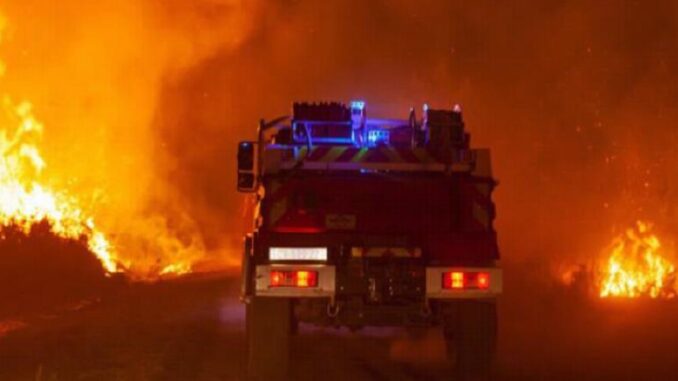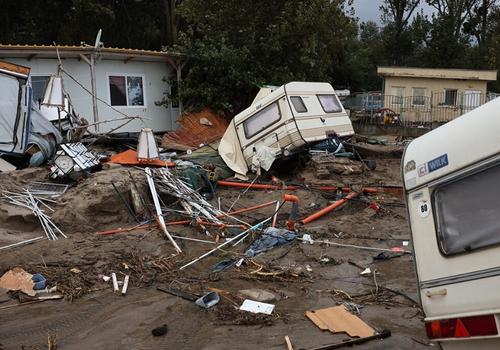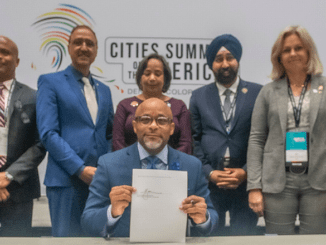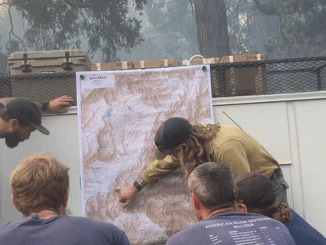
GENEVA, Switzerland, November 13, 2023 (ENS) – Temperature records were again shattered in October, continuing a streak of high land and ocean surface temperatures and low sea ice, according to the European Union’s Copernicus Climate Change Service, C3S.
October was the fifth month in a row of record-warm global temperatures, and it was by far the warmest October on record – 0.85°C (33.5°F) above the 1991-2020 average, and 0.40°C (32.7°F) above the previous warmest October.
The global mean temperature is the highest ever recorded – 1.43 degrees Celsius above pre-industrial levels – and sea ice in the Antarctic remains at record low levels.
This means that 2023 is almost certain to be the warmest year on record, the UN World Meteorological Organization predicted this week.
WMO says it will confirm this in its provisional State of the Global Climate 2023 report, set for release on November 30, the opening day of COP28, the UN Climate Change conference taking place in Dubai, United Arab Emirates.
Southern Europe has been especially hard hit. The start of October in Spain this year was the warmest since records began, the country’s meteorological agency AEMET said at the time, with nearly 40% of weather stations recording maximum temperatures above 32 degrees Celsius (89.6 Fahrenheit).

Spaniards endured a summer with four heatwaves over 24 days, part of a global pattern of rising temperatures attributed by scientists to human activity.
“In most of the Iberian Peninsula, temperatures on October 1 were between seven and 14 degrees above normal for this time of the year,” said AEMET spokesperson Ruben del Campo, who pointed to almost 100 individual records that were beaten.
In Greece, between July 23 and July 27, more than 20,000 people were evacuated from the island of Rhodes due to wildfires, which have swept homes and hotels. It’s the largest wildfire evacuation Greece had ever seen.
The Italian island of Sardinia experienced 47 degrees C, and a red alert was placed on all major Italian cities. Sicily’s Palermo airport was encircled by wildfire.
Over the last 10 years, more than 400,000 people have died from extreme climate and weather-related disasters, according to the International Federation of the Red Cross Red Crescent World Disasters Report.
In the Netherlands on Sunday, tens of thousands of climate change demonstrators marched through the streets of Amsterdam, calling for more action to tackle climate change, just 10 days before a national election.
Climate change is one of the key policy areas for political parties contesting the November 22 general election.
Organizers claimed that 70,000 people took part in the march and called it the biggest climate protest ever in the Netherlands.

Climate activist Greta Thunberg was among those marching through the Dutch capital. She and former European Commission climate leader Frans Timmermans, who now leads a center-left, two-party bloc in the Dutch election campaign, were among speakers to address the crowd.
As she spoke, Thunberg was interrupted by a man who approached her on stage after she invited a Palestinian and an Afghan woman to speak and offered them some of her allotted time.
“As a climate justice movement, we have to listen to the voices of those who are being oppressed and those who are fighting for freedom and for justice,” Thunberg declared. “Otherwise, there can be no climate justice without international solidarity.”
El Niño Triggers Rising Temperatures
The WMO expects the mercury to keep rising as the warming El Niño effect in the eastern tropical Pacific Ocean continues at least until April 2024, contributing to an even higher spike in global temperatures.
Professor Petteri Taalas, the Finnish meteorologist who serves as secretary-general of the World Meteorological Organization. says that as El Niño’s impacts on global temperature typically play out in the year after its development, the year 2024 “may be even warmer.”
While El Niño a a natural phenomenon, it is taking place in the context of climate change characterized by “increasing concentrations of heat-trapping greenhouse gases from human activities,” Taalas said.
He warned that extreme weather events such as heatwaves, drought, wildfires, heavy rain and floods will be worse in some regions. “That is why WMO is committed to the Early Warnings For All initiative to save lives and minimize economic losses,” Taalas said.
Early Warnings For All an Urgent Need
The need for early warning systems grows ever more urgent as the global climate changes, putting greater numbers of lives at risk more frequently with extreme weather, heatwaves, wildfires and rising seas.
Yet, as of 2022, only half the world’s countries are protected by multi-hazard early warning systems. The numbers are even lower for developing countries. Less than half of the Least Developed Countries and only one-third of Small Island Developing States have a multi-hazard early warning system, the UN says.
UN Secretary-General Antonio Guterres, in 2022 called for a global effort to ensure that early warning systems protect everyone on Earth by 2027.

Systems that warn people of impending storms, floods or droughts are not a luxury but a cost-effective tool that saves lives, reduces economic losses, and provides a nearly tenfold return on investment, he explains in an online statement.
To strengthen disaster risk knowledge and management, observation and forecasting, communication of warnings, preparedness and response capabilities in these underserved areas, the UN’s Early Warnings For All Action Plan calls for investments of US$3.1 billion over five years.
“The facts are clear. Early warnings save lives and deliver vast financial benefits. I urge all governments, financial institutions and civil society to support this effort,” Secretary-General Guterres said.
Early Warnings For All leverages existing pooled funding mechanisms, such as the Climate Risk and Early Warning Systems initiative and the Systematic Observations Financing Facility, as well as global multilateral funds, including the Green Climate Fund and the multi-lateral development banks.
The Multilateral Development Banks announced that they support the secretary-general’s US$3.1B initiative to ensure that everyone on Earth is protected by life-saving early warning systems in the face of increasingly more extreme and dangerous weather.
“At a cost of just 50 cents per person, this is a feasible and achievable sum to protect everyone in the face of escalating climate risks,” the banks said.
The announcement at the United Nations Secretary-General’s Climate Ambition Summit came as catastrophic flooding in Libya magnified the need for end-to-end early warning systems and coordinated disaster risk and response policies.
The declaration of support for Early Warnings For All was endorsed by the World Bank, Inter-American Development Bank, Asian Development Bank, African Development Bank, Islamic Development Bank, Caribbean Development Bank, European Investment Bank, the Council of European Development Bank and European Bank for Reconstruction and Development.
Momentum is building around the initiative. The UN Development Programme (UNDP) today launched a multi-country project to scale up early warning systems. Initial funding from the Green Climate Fund (GCF) will be used to kick-start a project preparation facility, which aims to deliver US$157 million from the GCF and partner governments to advance towards universal early warning coverage.
The Early Warnings For All Initiative, EW4All, was formally launched by the UN secretary-general in November 2022 at the COP27 meeting in Sharm El-Sheikh, Egypt.
The Initiative calls for the whole world to be covered by an early warning system by the end of 2027.

Early Warnings for All is co-led by WMO and the UNDRR and supported by pillar leads ITU and IFRC. Implementing partners include FAO, OCHA, UNDP, UNEP, UNESCO, REAP, and WFP, among other partners.
Translation: Early Warnings for All is co-led by the World Meteorological Organizations and the United Nations Office for Disaster Risk Reduction and supported by pillar leads International Telecommunication Union and the International Federation of Red Cross and Red Crescent.
Implementing partners include the Food and Agriculture Organization, FAO; UN Office for the Coordination of Humanitarian Affairs, OCHA; the UN Development Programme, UNDP; the UN Environment Programme, UNEP; the UN Educational, Scientific and Cultural Organization, UNESCO; the Risk-Informed Early Action Partnership, REAP; and the World Food Programme, WFP.
Featured image: Large parts of Europe were hit by intense, prolonged heat waves in 2023. Low rainfall and high temperatures led to widespread drought, and carbon dioxide emissions from forest fires during the summer were the highest in 20 years in some countries. (Photo courtesy International Association of Fire and Rescue Services)
© 2023, Environment News Service. All rights reserved. Content may be quoted only with proper attribution and a direct link to the original article. Full reproduction is prohibited.



